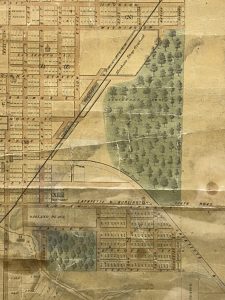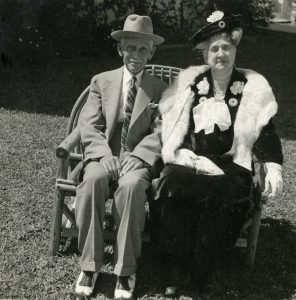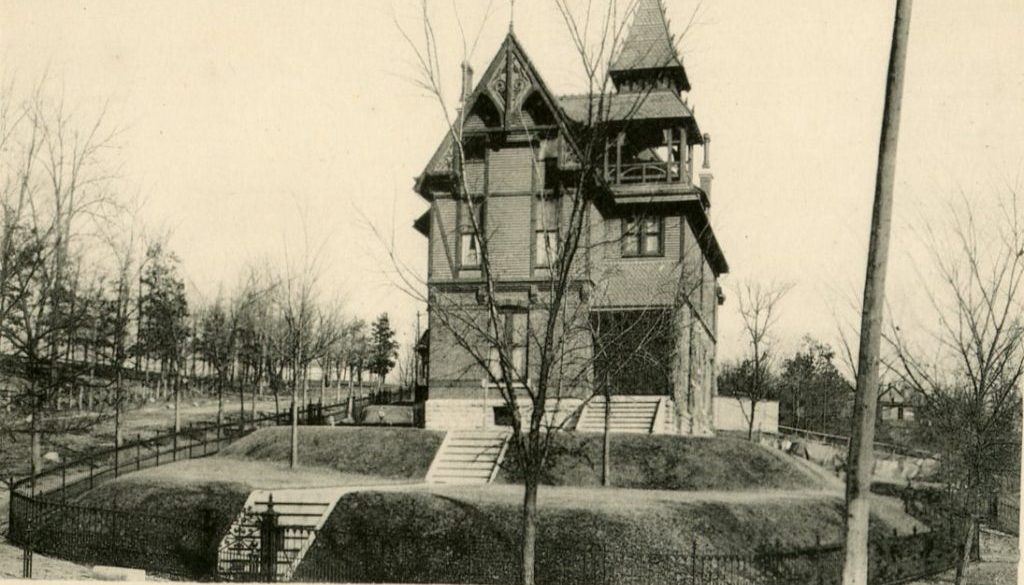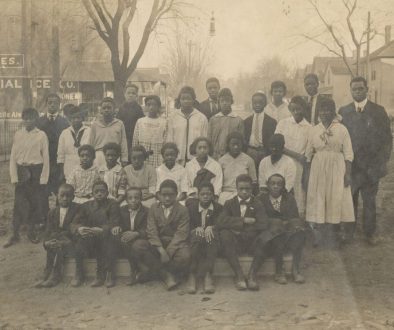The Perrins and Their Avenue
By Kitty Koehler and Phyllis Dix
This article first appeared in the TCHA newsletter, Weatenotes, Vol. x, No. 5, June-July 1976
A year before the city of Lafayette was laid out, a man named Newberry Stockton purchased a Certificate of Entry from the U.S. Government for a tract of ground including the area bordered by South Street, Norfolk and Western tracks, Union Street, North 18th, and reaching as far as Five Points (top of Main and South streets hill). One year later, in 1825, this certificate was assigned to Lawrence B. Stockton. The purchase price was $350 for 80 acres. Known as Stockton’s Woods, it remained undeveloped until 1873.

James J. Perrin, born in Virginia in 1829, had moved to Rossville, Indiana, in 1847, where he was in the farming business, then to Lafayette in 1869. He purchased for his residence the home of James Blake, a general contractor. Then known as Oakland Avenue and now as Main Street, it overlooked from the south the addition he was soon to plat called Perrin’s Addition. His wife, Margaret Cason Perrin, was the daughter of a wholesale grocer. In Lafayette, Mr. Perrin pursued the banking business as president of the Indiana National Bank, which in 1891 was re-named the Perrin National Bank.
Meanwhile, with the growth of the railroad system, started in 1856, the Toledo, Wabash, and Western was completed into Lafayette in 1874. Its success as transport for goods and services into Lafayette, as well as passenger service, caused such a business boom that by 1886 Lafayette was second in the Union in per capita wealth. Mr. Stockton was rewarded for his investment a half-century earlier, probably greater than his wildest dream. For in May 1873 Mr. Perrin purchased 63.952 acres of land from him for $63,952, or the tidy sum of $1000 per acre! The Perrin Addition became “the place to live”.
For this venture, Mr. Perrin had to enlist the short-term financial assistance of several prominent citizens—Edward Asher, John C. Brockenbrough, Consider Tinkler, Adams Earl, John Coffroth, John Quincy Adams Perrin, and Charles Mayo. But lots in the newly platted Perrin Addition sold quickly and in just three years, Mr. Perrin paid his debts and was sole owner. Several of the streets in the addition bear the names of the investors. North 18th Street was platted as Earl Avenue, and Ferry Street east of the railroad tracks was named Coffroth Avenue. The principle street curving gently through the center of the addition bears the family name, “Perrin” Avenue; and another bears his wife’s maiden name, “Cason”.

Several children were born to James and Margaret Perrin, some living only a few short years. Two sons joined Mr. Perrin in the banking business. It was his son, William who in 1891 married Mary (Minnie) Weaver, daughter of a prominent pioneer family in Lafayette. For their wedding, the James Perrins had the house at 1509 Cason built to give them as a wedding gift. William and Mary are the Perrins so many local residents refer to as “The Perrins”.
No one could quickly forget Mrs. Perrin. She dressed until her dying day, at age 93, as she had dressed when she was married, fancying herself in the attire of Queen Mary of England. Her perfectly proper manner at all times made her the subject of much conversation, completely over-shadowing her gentle husband and three children. Mrs. Perrin was a lady of methodic discipline, whether in her daily routine, her party entertaining, or her style of dress.

William and Mary had three children, Luella, Ethel and William. Luella married Elwood Sanger White and preceded her father in death in 1943, leaving two children, Mary White Rose and John H. White. Ethel married William Ragsdale and had one son. Ethel is also deceased. “Bill” was married and at last knowledge was residing in Atlanta, Georgia.
The house at 1509 Cason remained the family home after Mr. Perrin’s death in 1944 and until Mrs. Perrin’s death in 1951. In 1970, a group was formed to help preserve the neighborhood and was eventually called the Perrin Neighborhood Association. The Perrin Historic District was listed on the National Register of Historic Places in 1979, the first Tippecanoe County neighborhood to be listed. The Indiana Historical Bureau placed a state historic marker there in 1992.



